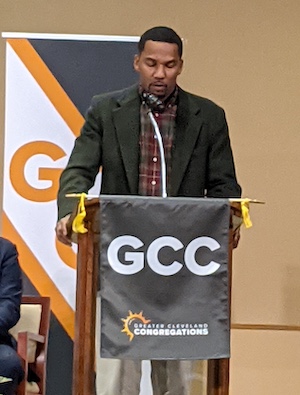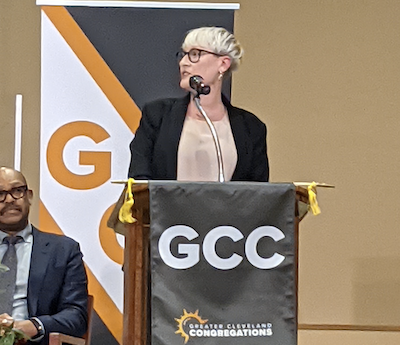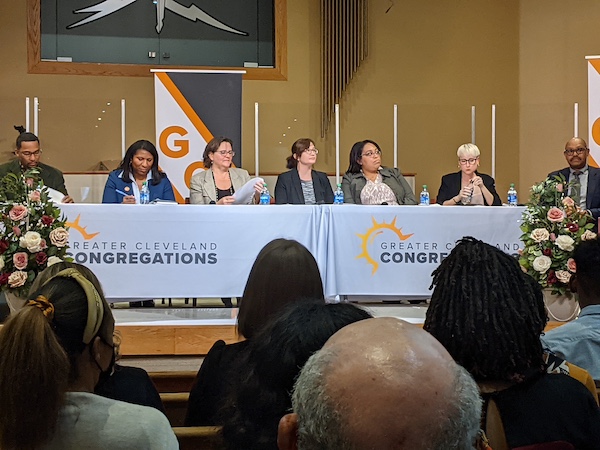
Whoever casually dismisses a failing grade in an elective class as a mere hiccup on a student’s path to eventual graduation may want to hear Ronnie Cannon’s testimony earlier this month at a public hearing on juvenile bindovers. Cannon’s “F” was but one of many trapdoors steering him and thousands of systematically targeted black and brown youth into the adult penal system.
“An ‘F’ meant that I was kicked off the track team,” recounted Cannon, now 45, but who in 1991 was an impressionable 14-year-old East Cleveland middle schooler. “All of my friends were on the track team, so that’s what they talked about in class. Since I couldn’t talk about it, I started distancing myself from school and started roaming the streets. Fast forward from 1991 to 1993, people asked me ‘Why would you need a gun?’ Back then, people were being robbed for Starter jackets and tennis shoes. I told myself I didn’t want that to happen to me. So being idiotic, I listened to friends who told me ‘(the gun) is for protection, Ronnie.’
That gun was used in an altercation I had with a neighbor; that led me to being arrested and led me into the juvenile justice system.”
Cannon currently holds the position of community engagement manager for Towards Employment; but his testimony describes what typically results from the grossly overused juvenile bindover system that experts say steers youth to a future of hopelessness.
Cannon’s testimony was presented before nearly one thousand concerned in-person and online attendees — including newly-elected juvenile court judge Ann McDonough and incoming county executive Chris Ronayne — at a December 6th public hearing. The hearing was sponsored by the community interfaith organization Greater Cleveland Congregations (GCC) at Olivet Institutional Baptist Church at East 86th St. and Quincy Ave [44104].
Cannon’s message set the stage for a panel of youth advocates, attorneys, educators and county government officials. The panelists offered the opportunity for guests to participate in solutions that they hope will lead to dismantling the cycle of juvenile bindover abuses. “We are here to discuss reforms,” began Ben Sperry, a co-chair of the Bindover Team of GCC. “Currently, there is no plan nor policy to reduce youth bindover decisions in Cuyahoga County. Tonight, the discussion will begin to focus on (these) three very important public offices.”

According to recent county court data, discretionary bindover happens to non-white youth at a rate several times higher in Cuyahoga County than in the combined county juvenile courts cases of Columbus, Toledo, Dayton, and Cincinnati. It’s the direct result of a mass stigmatization that was aimed at Gen-Y youth of color in Ohio’s densest urban centers, according to Leah Winsberg, an attorney with the Children’s Law Center.
“In the 1990s, what we saw was a false rhetoric labeling children of color as ‘super predators’ and blaming them for this incoming wave of crime and epidemics and all sorts of turmoil in communities,” said Winsberg. “What we saw as a result were some very highly publicized and sensationalized cases, even though they were isolated. We saw every state adopt or expand their laws in ways to treat children as adults.’”
Despite that the ‘super predator’ label was proven statistically untrue, and the predicted crime wave never happened, the new laws were never removed, and have been consistently over-applied to youth of color, Winsberg said.
Panel member Katherine Sato, a public defense attorney in the Ohio Public Defender Office’s Youth Defense Department, told the gathering that alternatives exist that have proven effective in the rehabilitation of youth offenders.
“National reforms in juvenile bindover have accomplished many things across the nation,” according to Sato. “We have eliminated a myriad of transfer laws, increased the age limit for bindover, and have received commitments from prosecutors to analyze bindovers in their jurisdictions.”
A 2013 study on alternative juvenile offender programs noted the effectiveness of using special juvenile courts whose processes take into account mitigating factors such as offender mental illness and cognitive developmental needs. It also proposed a “youth discount” which would credit the offender with time served for agreeing to specific intervention measures. Adult courts by design are not equipped to offer these alternatives nor address mitigating factors unique to teen offenders that often contribute to their criminal activity.
Additionally, the damaging effects of adult prisons on juveniles is prevalent, according to GCC’s Sperry. “We have learned over the years that bind-over does not reduce crime, but in fact decreases community safety. It leads to increased recidivism and increased chances of youth suicide. It deprives our youth of access to a wide range of youth services that are available in the juvenile court.”

The balance of the evening included a mix of assorted positive testimonies of how each of the county offices has recently begun to rethink its role in the current crisis. “We must stop overcharging youth (with bindover practices), “ said Winsberg. “[The justice system] must only consider what the facts support when it comes to youth offenders, and not try to seek a bargain for the system.”
Added Sato, “We have to start carrying bindover cases back to the public defender’s office and out of the hands of private law firms,” adding that defendants’ families are often unable to afford payments to private attorneys and are subsequently under-represented. “Start showing up at public hearings where the judges are making these decisions on the youth. It sends the message to the presiding judges that they are being watched when you are there.”
Other panelists offered ways the public can become immediately involved. Takasha Smith, the executive director and policy director of Ohio’s Juvenile Justice Coalition, encouraged attendees to “fund policies and initiatives that will reduce juvenile injustices.
Take the steps (as role models) that will stop children from entering the system in the first place.” Concluded Cannon, “Reach out to kids in your neighborhood before it even gets to this level.”
For more information on discretionary youth bindover, visit the Ohio Public Defender website and/or the Children’s Law Center.
• • •• • •














